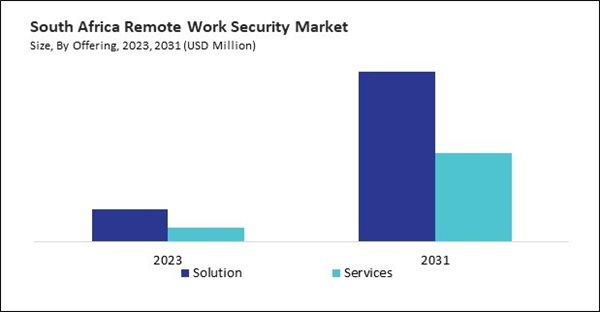The Brazil market dominated the LAMEA Remote Work Security Market by Country in 2023, and would continue to be a dominant market till 2031; thereby, achieving a market value of $5.38 billion by 2031. The Argentina market is showcasing a CAGR of 25.6% during 2024-2031. Additionally, the UAE market would register a CAGR of 23.9% during 2024-2031.
Organizations are increasingly adopting security automation tools to manage the complexity of the work security. Automation alleviates the workload of security teams and enhances response times by automating tasks such as compliance monitoring, threat detection, and incident response. There is a growing trend towards developing and adopting security solutions tailored to specific industries. These solutions address the healthcare, finance, and education sectors’ unique regulatory, compliance, and operational requirements.
Innovation is crucial in the Remote Work Security Market, as organizations and security vendors continuously seek to address evolving threats and challenges. Artificial intelligence (AI) innovations are being applied to hunt for threats proactively before they cause damage. AI-driven threat-hunting tools analyze patterns and anomalies across large datasets to identify potential security threats in remote work environments. With the advent of quantum computing, quantum-resistant encryption methods are being developed to secure data against future quantum-enabled attacks. These innovations are crucial for protecting sensitive information in a post-quantum world.
As cloud computing gains traction in the UAE, organizations increasingly adopt cloud-based tools for remote work, such as collaboration platforms and document storage solutions. This shift drives demand for enhanced cloud security measures to protect data and applications accessed remotely. The UAE is one of the major data center hubs in the Middle East, according to the International Telecommunications Association (ITA), and additional facilities are being developed. By 2026, it is anticipated that there will be an additional $1 billion in investments. Brazilian e-commerce companies must handle large volumes of customer data. Ensuring the security of this data from remote work environments is critical, necessitating secure data storage solutions and encryption to prevent data breaches and misuse. International Trade Administration (ITA), Brazil is one of the most populous nations in Latin America, and its e-commerce sector is anticipated to surpass US$200 billion by 2026, expanding at 14.3% annually. In conclusion, increasing cloud computing and the rising e-commerce sector in the region are driving the market’s growth.
List of Key Companies Profiled
- Cisco Systems, Inc.
- VMware, Inc. (Broadcom Inc.)
- Palo Alto Networks, Inc.
- Check Point Software Technologies Ltd.
- Trend Micro, Inc.
- Fortinet, Inc.
- IBM Corporation
- Microsoft Corporation
- Sophos Group PLC (Thoma Bravo)
- Cloudflare, Inc.
Market Report Segmentation
By Offering
- Solution
- Services
By Work Model
- Full Remote
- Hybrid
- Temporary Remote
Security Type
- Endpoint & IoT Security
- Network Security
- Cloud Security
- Application Security
By End User
- BFSI
- IT & Telecom
- Government
- Retail & E-Commerce
- Education
- Media & Entertainment
- Others
By Country
- Brazil
- Argentina
- UAE
- Saudi Arabia
- South Africa
- Nigeria
- Rest of LAMEA
Table of Contents
Companies Mentioned
- Cisco Systems, Inc.
- VMware, Inc. (Broadcom Inc.)
- Palo Alto Networks, Inc.
- Check Point Software Technologies Ltd.
- Trend Micro, Inc.
- Fortinet, Inc.
- IBM Corporation
- Microsoft Corporation
- Sophos Group PLC (Thoma Bravo)
- Cloudflare, Inc.
Methodology

LOADING...









